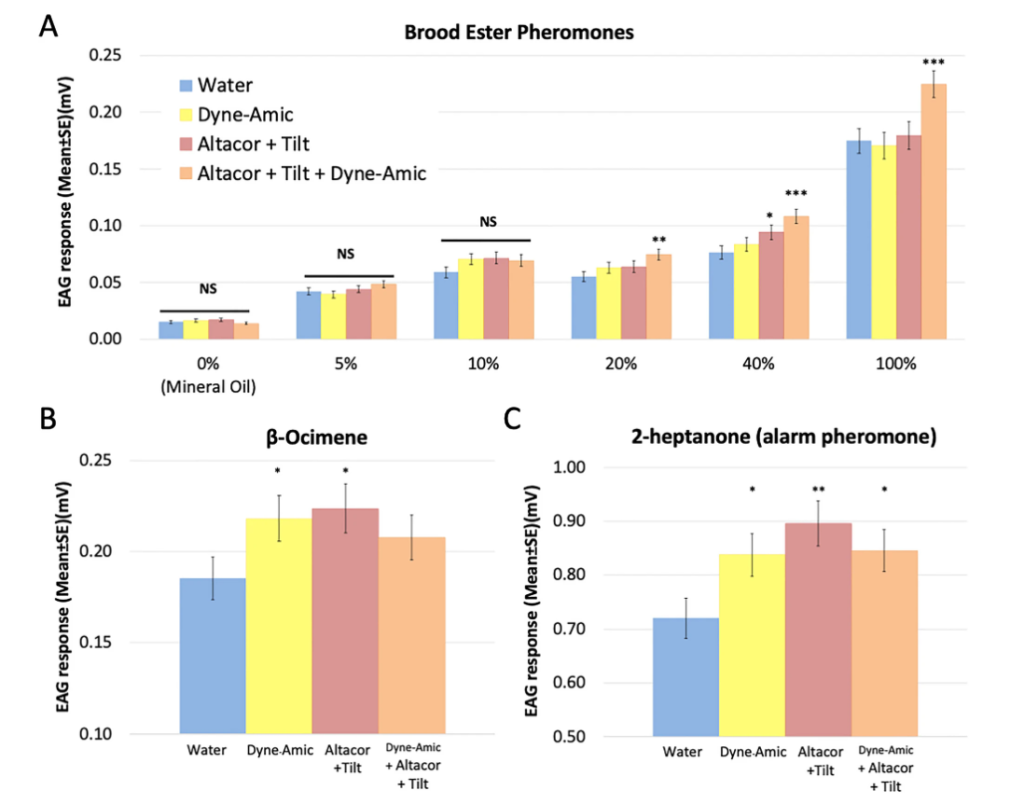
Electroantennogram (EAG) responses of adult honey bee workers to social signals after exposure to the organosilicone adjuvant Dyne-Amic, the fungicide Tilt and the insecticide Altacor, alone or in combination: (A) brood-emitted ester pheromone (BEP), (B) β-ocimene (larval volatile pheromone), and (C) 2-heptanone (alarm pheromone). The EAG responses of bees that consumed pollen with water, representing the control group, are shown in blue. The other three groups, including the Dyne-Amic adjuvant treatment (shown in yellow), the Altacor + Tilt pesticide treatment (shown in red), and the Altacor + Tilt + Dyne-Amic adjuvant-pesticide mixture treatment (shown in orange), are referred to as treatment groups. The asterisk symbol (*) indicates a statistically significant difference in the EAG responses of each treatment group (Dyne-Amic, Altacor + Tilt, or Altacor + Tilt + Dyne-Amic) compared to the EAG responses of bees in the control group that consumed pollen with water, using the same concentration of tested stimuli. The estimated marginal mean of EAG response ± SE is listed. (NS: p > 0.05, *: p < 0.05, **: p < 0.01, ***: P < 0.01, N = 106, GEE test).
Effects of pesticide-adjuvant combinations used in almond orchards on olfactory responses to social signals in honey bees (Apis mellifera)
Scientific Reports volume 13, Article number: 15577 (2023) Cite this article
Abstract
Exposure to agrochemical sprays containing pesticides and tank-mix adjuvants has been implicated in post-bloom mortality, particularly of brood, in honey bee colonies brought into California almond orchards for pollination. Although adjuvants are generally considered to be biologically inert, some adjuvants have exhibited toxicity and sublethal effects, including decreasing survival rates of next-generation queens. Honey bees have a highly developed olfactory system to detect and discriminate among social signals. To investigate the impact of pesticide-adjuvant combinations on honey bee signal perception, we performed electroantennography assays to assess alterations in their olfactory responsiveness to the brood ester pheromone (BEP), the volatile larval pheromone β-ocimene, and the alarm pheromone 2-heptanone. These assays aimed to uncover potential mechanisms underlying changes in social behaviors and reduced brood survival after pesticide exposure. We found that combining the adjuvant Dyne-Amic with the fungicide Tilt (propiconazole) and the insecticide Altacor (chlorantraniliprole) synergistically enhanced olfactory responses to three concentrations of BEP and as well exerted dampening and compensatory effects on responses to 2-heptanone and β-ocimene, respectively. In contrast, exposure to adjuvant alone or the combination of fungicide and insecticide had no effect on olfactory responses to BEP at most concentrations but altered responses to β-ocimene and 2-heptanone. Exposure to Dyne-Amic, Altacor, and Tilt increased BEP signal amplitude, indicating potential changes in olfactory receptor sensitivity or sensilla permeability to odorants. Given that, in a previous study, next-generation queens raised by nurses exposed to the same treated pollen experienced reduced survival, these new findings highlight the potential disruption of social signaling in honey bees and its implications for colony reproductive success.
We are here to share current happenings in the bee industry. Bee Culture gathers and shares articles published by outside sources. For more information about this specific article, please visit the original publish source: Effects of pesticide-adjuvant combinations used in almond orchards on olfactory responses to social signals in honey bees (Apis mellifera) | Scientific Reports (nature.com)






